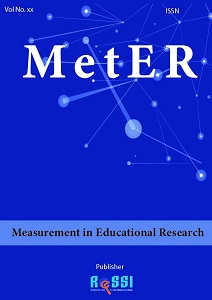Perbandingan metode Skala Thurstone dalam mengukur kompetensi kepribadian guru
DOI:
https://doi.org/10.33292/meter.v1i2.162Keywords:
Penskalaan, Thurstone, kompetensi kepribadian guruAbstract
Tujuan penelitian ini adalah untuk membandingkan akurasi hasil penskalaan instrumen kompetensi kepribadian guru pada tipe thrustone menggunakan metode interval tampak setara dan interval sukesif. Pendekatan pada penelitian ini menggunakan kuantitaif deskriptif. Subjek penelitian yaitu 62 guru di Kabupaten Tasikmalaya dengan karakteristik tingkat mengajar yang berbeda. Instrumen pengukur Kompetensi kepribadian guru diadaptasi dari artikel sebelumnya yang telah diuji validitas dan reliabiltasnya. Teknik analisis data yang digunakan yaitu menentukan Nilai S dan Q pada skala thrustone, kemudia diuji reliabilitas baru menggunakan persamaan KR 20 dan standar kesalahan pengukuran menggunakan teori tes klasik. Hasil analisis skala thrustone menggunakan nilai S dan Q menunjukkan bahwa terdapat 10 butir pernyataan yang dibuang dan terjadi perubahan urutan butir pada metode interval tampak setara dan interval sukesif. Hasil uji reliabilitas baru untuk metode interval tampak setara didapatkan nilai estimasi koefisien sebesar 0,83 dengan standar kesalahan pengukuran sebesar 1,49, sedangkan reliabilitas untuk interval sukesif sebesar 0,83 dengan standar kesalahan pengukuran sebesar 2,57. Hasil-hasil analisis pada setiap langkah menunjukkan bahwa skor hasil penskalaan pada metode interval tampak setara akan berbeda dengan metode interval berurutan.
Kata Kunci: Penskalaan, thrustone, kompetensi kepribadian guru
Â
Comparison of the Thurstone Scale method in measuring teacher personality competence
Â
Abstract: The purpose of this study was to compare the accuracy of the results of scaling the teacher's personality competency instrument on the Thurstone type using the seemingly equivalent and successive interval methods. The approach in this study uses descriptive quantitative. The research subjects were 62 teachers in Tasikmalaya Regency with different teaching level characteristics. The instrument for measuring teacher personality competence was adapted from the previous article, which had been tested for validity and reliability. The data analysis technique used was to determine the S and Q values on the Thurstone scale, then tested the new reliability using the KR 20 equation and the standard error of measurement using the classical test theory. The results of the Thurstone scale analysis using the values of S and Q indicate that there are ten items of statements that are discarded, and there is a change in the order of the items in the interval method that looks equal and successive intervals. The results of the new reliability test for the interval method seem equivalent. The estimated coefficient value is 0.83 with a standard error of measurement of 1.49, while the reliability for successive intervals is 0.83 with a standard error of measurement of 2.57. The results of the analysis at each step show that the score of the results of the scaling on the interval method looks equal will be different from the sequential interval method.
References
Atkinson, R. C., & Paulson, J. A. (1972). An approach to the psychology of instruction. Psychological Bulletin, 78(1), 49.
Azwar, S. (2012). Penyusunan skala psikologi. Pustaka Pelajar.
Basuki, I., & Hariyanto, M. S. (2014). Asesmen pembelajaran. PT Remaja Rosdakarya.
Corr, P. J., & Matthews, G. (2020). The Cambridge handbook of personality psychology. Cambridge University Press.
Crocker, L., & Algina, J. (2008). Introduction to classical and modern test theory Mason. Cengage Learning.
Hashim, N. M. H. N., Alam, S. S., & Yusoff, N. M. (2014). Relationship between teacher’s personality, monitoring, learning environment, and students’ EFL performance. GEMA Online Journal of Language Studies, 14(01), 101–116. https://doi.org/10.17576/GEMA-2014-1401-07
Hays, W. L. (1969). Quantification in psychology. Prentice Hall of India.
Istiyono, E. (2018). Pengembangan instrumen penilaian dan analisis hasil belajar fisika dengan teori tes klasik dan modern. UNY Press Yogyakarta.
Kartowagiran, B., Suyanta, S., Hamdi, S., Jaedun, A., Ahman, A., Rusijono, R., & Laliyo, L. A. (2020). Development of web-based application for teacher candidate competence instruments: Preparing professional teachers in the IR 4.0 era. European Journal of Educational Research, 9(4), 1749–1763. https://doi.org/10.12973/eu-jer.9.4.1749
Mawardi, M. (2019). Rambu-rambu penyusunan skala sikap model Likert untuk mengukur sikap siswa. Scholaria: Jurnal Pendidikan Dan Kebudayaan, 9(3), 292–304. https://doi.org/10.24246/j.js.2019.v9.i3.p292-304
Undang-Undang Republik Indonesia Nomor 14 Tahun 2005 tentang guru dan dosen, Pub. L. No. 14 (2005).
Retnawati, H. (2016). Analisis kuantitatif instrumen penelitian. Parama Publishing.
Sarwono, J. (2012). Mengubah data ordinal ke data interval dengan metode suksesif interval (MSI) (pp. 250–259).
Setiawati, F. A. (2014). Perbandingan berbagai metode penskalaan yang dikembangkan Thurstone. Jurnal Penelitian Ilmu Pendidikan, 7(1). https://doi.org/10.21831/jpipfip.v7i1.3114
Shaw, M. E., Hawley, G. G., & Wright, J. M. (1967). Scales for the measurement of attitudes. New York: McGraw-Hill.







